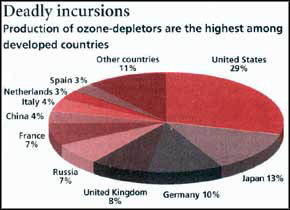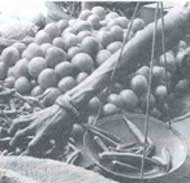
Mad hatter's tea party
Some US based environmental wisemen started out to debate Bihar's problems, sans field knowledge, and went back home foot in mouth

Some US based environmental wisemen started out to debate Bihar's problems, sans field knowledge, and went back home foot in mouth
THROUGHOUT the developed world today, there is a determined effort to clean up the air, and railways are being pushed as the most convenient, eco-friendly, cheap, fast and comfortable mode of

Of all dyes produced across the world, 11 per cent goes out as effluents. 2 per cent from manufacturing and as much as 9 per cent from colouring. Each year, India produces 64,000 tonnes of dyes, 7,040 tonnes of which are directly discharged into the envir

As concern for the ozone layer mounts, two more chemicals have been found to have a degenerating effect on the protective shield

..but that is not the end of problems for Ukraine, as answers to important issues' like the future of workers and alternate energy and monetary resources are still to be found

The six year long wait for the Galileo trip to Jupiter started paying off scientific returns last fortnight, as the data sent by the probe was analysed and NASA scientists released the first results
The book claims to be a "counter-factual" rebuke to the critics of the Sardar Sarovar Project (SSP). But both the claim and the title of the book are misleading. First, in 5 short pages, the book
Research is often like an iceberg. The public interest can just be the visible tip with the invisible bulk being the private interest

... when its controversial actions invariably invite flak

A lot of sound and fury signifying nothing: that was the Social Development battlefield at Copenhagen

Scientists working on department of science and technology's high altitude projects face a bleak future

Why are pretty films on wildlife so much more interesting than no holds barred environmental documentaries?

although the importance of Himalaya-Karakoram as the largest storehouse of fresh water in the lower latitudes, and the important role of their snow and ice in maintaining the flows of the Indus,

Despite vehement domestic and international opposition, China has decided to go ahead with the massive new dam project on the Yangtze

Development can spawn curious offspring. The prospect of involving rural women in a refresher course on the importance of maintaining vegetable gardens surely qualifies as one of these. And that's
It will provide only short-term relief THERE arefour crore small and marginal farmers who are unable to repay their crop loans to the banks. The Rs 60,000-crore budgetary allocation for waiving their loans will now enable a farmer to go back to the same bank, apply for another loan and await either of these two outcomes: a good crop or another loan waiver. While the gesture provides farmers relief in the short term, it would be harmful for the economy, especially the farm economy, in the long run. If we take the risk versus reward incentive out of an economic activity such as agribusiness, the enterprise quotient diminishes and hinders both growth and innovation.These key attributes, along with structural reforms and investment in agri-infrastructure, are needed to raise agricultural productivity and maintain the growth trajectory of the economy. The question we need to ask ourselves is why these farmers have not been able to repay their crop loans. Can Rs 15,000-per-farmer reward help them produce a better crop in the next season? The answer sadly is No. Small farmers face two main challenges: meeting their input needs (seeds, pesticides) and dealing with the weather risks to their crops. Issuance of input coupons for purchase of quality inputs for the next season would have been more beneficial. Bad weather plays havoc with agriculture. Dealing with weather risk calls for appropriate risk management tools such as weather insurance. This requires a network of weather stations at the block level for timely collation of data, a basic requirement for weather insurance products. Establishing a network of weather stations would have required only a fraction of the Rs 60,000 crore outlay. The budget will definitely encourage the creation of rural enterprises such as nurseries and cold chain establishment. The one-time budgetary assistance of Rs 75 crore for setting up mobile soil testing facilities is also a good step. However, the provision of Rs 60,000 crore for loan waiver which can at best provide short-term relief to farmers has robbed them of possible agri-infrastructure projects such as roads, marketing and storage facilities, and irrigation which could have yielded better returns on a sustainable basis. (*Country Head, Food & Agribusiness Strategic Advisory & Research) RAKESH TIKAIT Spokesman, Bhartiya Kissan Union It will not solve the deepening agri crisis THE Union budget 2008-09 is prima facie a pro-farmer budget, with the primary emphasis on writing off the loans of small and marginal farmers. It is a good step to provide instant relief to farmers who are heavily indebted, although it covers only 40% of total farmers. However, the debt relief will not solve the deepening agrarian distress. Nevertheless, we see the announcement of debt waiver as a victory of farmers' union, activists and pro-farmer media. It was a great battle and we are grateful that the finance minister took this step despite corporate pressure. We believe that this measure alone is not enough to address the farmers' problems. It is well known that the basic problem faced by farmers is their inability to get fair price for their produce. The policy makers have said nothing on this count. Nothing has also been said about ensuring better farm gate price for agriculture commodities or making available a price stabilisation fund to help farmers increase their income. The price offered for the commodities produced by them must not only fully cover their cost of production but also ensure livelihood security. Subsidy is another area of concern. Traders and producers are currently getting all the benefits while farmers have to suffer due to scarcity of fertiliser. The budget has also not made any announcement to strengthen the extension services of the ministry of agriculture to make it more relevant for the farmers. As a result, farmers are forced to depend on agents of pesticide and seed companies for technical advice. It seems that the government has made up its mind to hand over this system to the corporate sector. In this context, we are closely watching the Indo-US knowledge agreement and the multinational companies in seed business. In conclusion, although the budget is pro-farmer, the actual need of the Indian farmer is not just the removal of debt and interest. Many other important issues need to be addressed. These include access to market, fair price for produce, timely availability of fertilisers and seeds, direct subsidy and the public sector investment in agriculture business. We hope the government will consider all this in future. And the main need is to keep corporates far from farming business. K CHAKRAVARTHY Country Head* YES BANK
Loan waiver for farmers is a good beginning M K Venu A former bureaucrat who had worked with finance minister P Chidambaram in 1997 summed up the 2008-09 Budget aptly in the words of Edmund Burke: "Mere parsimony is not economy. Expenses and great expenses may be an essential part in true economy'. The bureaucrat in question, former revenue secretary N K Singh, had then designed one of the most liberal tax amnesty schemes for the urban rich with a view to mainstreaming sources of black money generation. The amnesty programme had later prompted even the Supreme Court to comment that such schemes must not become regular practice. Those were difficult times when a prolonged growth slump in much of Asia had led to sluggish revenue collections year after year. Budget targets were rarely met, if at all. Consequently, the government had to resort to amnesty schemes, in desperation, to collect more revenues. Things have dramatically changed in recent years. Asia is fast becoming the engine of growth, and India is a big part of the story. The government's revenues have soared from about Rs 2,54,000 crore in 2003-04 to Rs 5,85,000 crore in 2007-08, more than doubling in four years. With its coffers overflowing, the UPA government has chosen to embark on a "great expenses' programme. And why not? If you could give amnesty to the rich in difficult times, why not amnesty to the poor, distressed farmers when the coffers are full up? The Rs 60,000 crore farm loan waiver may have some design flaws, but no one today should quarrel with the sentiment that agriculture, and the small farmer, do need a leg-up. Clearly, the distress in the farm sector in recent years has created an adverse political climate for the UPA, which has been a bit shy of selling more aggressively the unprecedented GDP growth India has seen in the past five years. It is obvious that you cannot sell high GDP growth and bulging forex reserves in large parts of rural India which are in distress. This had also become a cause of persistent friction between the Congress and the Left within the UPA alliance. All this while, it would appear, it is this political tension which had resulted in the growing communication gap between the Congress and the Left. This may have had its spillover effect even on the nuclear deal. The Left would seem to have been somewhat assuaged by the Budget proposals. The CPM general secretary Prakash Karat has for the first time welcomed the farm and social sector programmes announced by the finance minister. This may signal a temporary thaw in the relations between the Congress and CPM. There is talk that the nuclear deal may also get revived, and the Left may not do any more than make some routine noises over it. The larger issue is one of creating a conducive atmosphere in the political economy to build a consensus for further reforms that are critical for India's economy to sustain a 9 per cent growth for the next five years. The massive farm loan waiver and higher spending in social sector programmes must be appropriately used now to bring down the political opposition to further reforms which are important to propel India to the next level in the globalisation sweepstakes. The Budget in some ways has signalled a New Deal, in which every section of society has benefited, whether it's the urban middle class or the rural poor. But these benefits must now be accompanied with some obligation to work towards a common goal. The one common objective, with which the CPM must have no quarrel, is promoting higher levels of industrialisation. The CPM has also formally recorded in its party document that rapid industrialisation is necessary and there is an urgent need to move people from low yield agriculture to industry. Prime Minister Manmohan Singh too has been placing repeated emphasis on this. The only caution that needs to be exercised is this process must be conducted in a democratic, bottom-up fashion. This was the prime lesson of Nandigram and Singur. The farm loan waiver must be seen as a purely temporary relief and there must be some programme by which farm families locked in low-yielding, suboptimal farm activity are moved to non-farm sectors. After one loan waiver, there is no point in their getting into another loan to do unremunerative agriculture. This would be a recipe for future fiscal disasters. Some permanent institutional arrangement must be designed by the Centre and states together to ensure that inherently remunerative farm activity gets a boost with technical, marketing and financial support. The other farm families must be encouraged through new skill development programmes to move to the manufacturing sector. This needs to be done in a focused manner. The Left Front government in West Bengal has designed an elaborate scheme, after the farmer protests in Nandigram, which seeks to handhold farm families for years after their shift to manufacturing townships built on their land. If done democratically, this is the only way to design a long-term solution to the problems of India's farm sector. A rapidly globalising economy just cannot afford 60 per cent of its population in agriculture sharing less than 20 per cent of the national income. This will remain the biggest point of tension in our political economy. The massive farm loan waiver in the Budget only addresses the symptom. Much more needs to be done to address the root cause. The Rs 60,000 crore loan waiver, at least, brings the whole issue to the centre stage. That is clearly a plus.
<p><span style="line-height:115%;color:rgb(51,51,51)">Lima witnessed the end game of a 20 year old negotiation around doing away with differentiation between countries at different levels of development

THE 2 books under review have established, dependable credentials, which is why they have the rare virtue of being eagerly awaited every year for additional insights on global developments. This

India with its deplorable rural roads can learn a lesson from Madagascar, which has successfully implemented a decentralised system of constructing roads